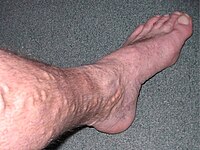
Photo from wikipedia
Background: Perioperative chemotherapy is a recommended treatment approach for localised oesophago-gastric junction adenocarcinoma, but not all patients respond to neoadjuvant chemotherapy. Early identification of non-responders and treatment adaptation in the… Click to show full abstract
Background: Perioperative chemotherapy is a recommended treatment approach for localised oesophago-gastric junction adenocarcinoma, but not all patients respond to neoadjuvant chemotherapy. Early identification of non-responders and treatment adaptation in the preoperative period could improve outcomes. GastroPET is a national, multicentre phase II trial evaluating a 18FDG-PET/CT-guided preoperative treatment strategy with the R0 resection rate as a primary endpoint. Here, we report on the accuracy of the methodology, the feasibility of the study design and patient safety data after enrolment of the first 63 patients. Methods: Patients with locally advanced oesophago-gastric junction adenocarcinoma (Siewert I – III) stage Ib–IIIc underwent baseline 18FDG-PET/CT scanning and re-evaluation after 14 days of oxaliplatinum-5FU-(docetaxel) chemotherapy. Responders were defined by a ⩾ 35% decrease in tumour FDG standardised uptake value (SUV)average from baseline. Responders continued with the same chemotherapy for 2 to 3 months prior to surgery. PET-non-responders switched to preoperative chemoradiotherapy [weekly carboplatin and paclitaxel with concurrent radiotherapy (45 Gy in 25 fractions)]. Here, we aim to confirm the feasibility of FDG-PET-based response assessment in a multicenter setting and to compare local versus central reading. In addition, we report on the feasibility of the study conduct and patient safety data. Results: A total of 64 patients received baseline and sequential 14-day 18FDG-PET/CT scanning. And, 63 were allocated to the respective treatment arm according to PET-response [35 (56%) responders and 28 (44%) non-responders]. The concordance of local versus central reading of SUV changes was 100%. Until the date of this analysis, 47 patients (28 responders and 19 non-responders) completed surgery. Postoperative complications of grade ⩾ 3 (Common Terminology Criteria for Adverse Events, CTCAE Version 5.0) were reported in five responders (18%; 95% CI: 7.9–36%) and two non-responders (11%; 95% CI: 2.9–31%), with no statistical difference (p = 0.685). One patient in each arm died after surgery, leading to a postoperative in-hospital mortality rate of 4.3% (2/47 patients; 95% CI: 1.2–14%). Conclusion: Local and central FDG-SUV quantification and PET-response assessment showed high concordance. This confirms the accuracy of a PET-response-guided treatment algorithm for locally advanced oesophago-gastric junction cancer in a multicenter setting. Preoperative treatment adaptation revealed feasible and safe for patients.
Journal Title: Therapeutic Advances in Medical Oncology
Year Published: 2021
Link to full text (if available)
Share on Social Media: Sign Up to like & get
recommendations!